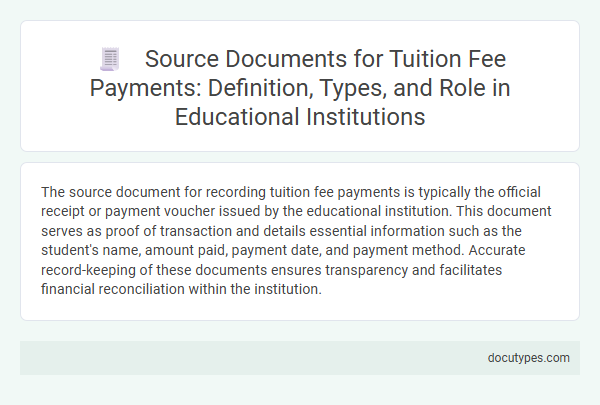The source document for recording tuition fee payments is typically the official receipt or payment voucher issued by the educational institution. This document serves as proof of transaction and details essential information such as the student's name, amount paid, payment date, and payment method. Accurate record-keeping of these documents ensures transparency and facilitates financial reconciliation within the institution.
Understanding Source Documents in Tuition Fee Transactions
| Aspect | Description |
|---|---|
| Source Document Definition | Original record that provides evidence for a financial transaction, essential for accuracy in accounting and auditing. |
| Purpose in Tuition Fee Transactions | Serves as proof of payment, details the amount received, payer identity, payment method, and transaction date. |
| Common Source Documents | Receipts issued by educational institutions, bank deposit slips, electronic payment confirmations, and tuition invoices. |
| Role in Financial Records | Supports the recording of tuition fees in student accounts, ensures accountability, and facilitates reconciliation of payments. |
| Legal and Compliance Importance | Maintains compliance with financial regulations and audit requirements, safeguarding institution's financial integrity. |
| Best Practices | Maintaining clear, organized, and accessible source documents helps prevent errors and supports transparent financial reporting. |
Definition and Importance of Source Documents in Education
Source documents for recording tuition fee payments are original records that provide proof of financial transactions between students and educational institutions. These documents include receipts, payment vouchers, and bank statements that verify the amount paid and the date of the transaction.
In education, source documents are crucial for accurate financial management and transparency. They serve as evidence for audits, help prevent discrepancies, and ensure accountability in tuition fee collection and recording processes.
Common Types of Source Documents for Tuition Payments
The source document for recording tuition fee payments is essential for accurate financial tracking in education institutions. Common types of source documents include payment receipts, bank statements, and online payment confirmations. You can rely on these documents to verify and record all tuition fee transactions effectively.
Receipts: The Primary Proof of Tuition Fee Payment
What is the source document for recording tuition fee payments? Receipts serve as the primary proof of tuition fee payment in educational institutions. These documents provide official confirmation of the amount paid and the date of the transaction, ensuring accurate financial records.
Invoices and Billing Statements in Educational Institutions
Invoices and billing statements serve as the primary source documents for recording tuition fee payments in educational institutions. These documents detail the amount owed by students, payment deadlines, and any applicable fees or discounts.
Educational administrators rely on invoices to track and verify tuition payments accurately. Billing statements provide a clear record that supports financial audits and student account reconciliation.
Bank Transfer Slips and Digital Payment Records
Source documents for recording tuition fee payments must provide clear and verifiable evidence of transactions. Bank transfer slips and digital payment records serve as essential proof of payment in educational institutions.
- Bank transfer slips - These official documents issued by banks confirm the transfer of funds from the payer's account to the institution's account.
- Digital payment records - Screenshots or digital receipts from payment platforms validate electronic money transfers securely and instantly.
- Verification and storage - You should retain these documents as part of student financial records for auditing and reconciliation purposes.
Role of Source Documents in Financial Accountability
The source document for recording tuition fee payments is typically the official receipt issued by the educational institution. This receipt serves as proof of payment and provides essential details such as the payer's name, amount paid, date, and payment method.
Source documents play a crucial role in maintaining financial accountability within educational institutions. They offer verifiable evidence for every transaction, which helps prevent errors and fraud. Your accurate record-keeping depends on these documents to ensure transparency and compliance with financial regulations.
Source Documents and Auditing in Schools and Universities
The source document for recording tuition fee payments in schools and universities is typically the official payment receipt issued upon transaction. These receipts serve as primary evidence in auditing processes, ensuring accuracy and transparency in financial records. You should always keep these documents organized for verification during internal and external audits.
Best Practices for Managing Tuition Fee Source Documents
The source document for recording tuition fee payments is typically the official receipt or payment confirmation issued by the educational institution. Proper management of these documents ensures accurate financial tracking and accountability in educational administration.
- Use Official Receipts - Only accept receipts generated by authorized institutional systems or finance departments to maintain authenticity.
- Maintain Digital Records - Store scanned copies of tuition fee payments in secure digital systems to facilitate easy retrieval and backup.
- Implement Consistent Documentation - Standardize the format and details captured in payment records to promote clarity and reduce errors in accounting.
Effective handling of tuition fee source documents supports transparent financial management and compliance within educational institutions.
What Is the Source Document for Recording Tuition Fee Payments? Infographic

